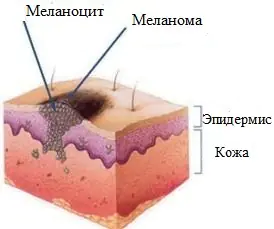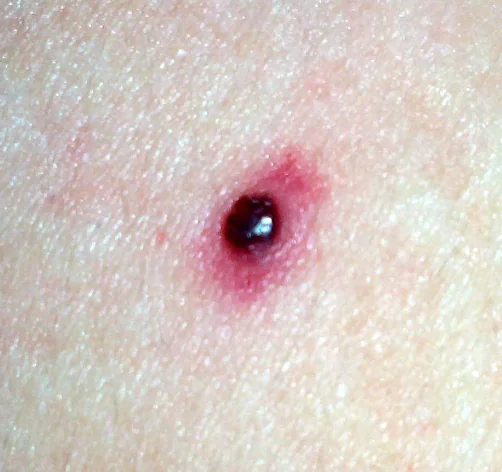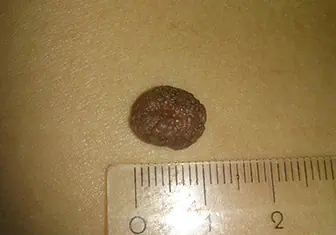
Any mole, even a relatively small one, can be easily damaged. If this happens, it is necessary, at a minimum, to treat the wound, and better yet, consult a doctor.
Moles are generally harmless. Only a few of them can develop into melanoma. However, any mole must be treated with great care. Moreover, if it is large enough and can be damaged.
Moles that protrude above the skin are not so difficult to damage and even tear off. And if this happens, the injury should not be ignored. As well as panic: many believe that damage can lead to serious illnesses, including cancer. But this is not entirely true.
Will trauma to a mole lead to melanoma (cancer)?
At the moment, scientists simply do not have data that would confirm that the cause of melanoma (skin cancer) is precisely damage to a mole. Yes, it is moles that degenerate into malignant formations, and they are the ones that can lead to serious consequences, but trauma has nothing to do with it. Read more about what skin cancer is in the article "Skin cancer: melanoma."
However, there is some truth here: after an injury, the process of degeneration of a mole accelerates. This is why many consider damage to be the cause of melanoma. But trauma itself cannot cause cancer - it only increases the rate of degeneration, which would have happened in any case, but a little later.
So does this mean that a mole injury is not dangerous?
Unfortunately, it is dangerous. It is possible that if damaged, you will introduce an infection into the wound. The result is infection, inflammation and, at the very least, unpleasant consequences.

Of course, if a mole is damaged, you can immediately treat it with an antiseptic and hide it under a bandage. But damage most often occurs at moments when a person simply does not have a band-aid, brilliant green or iodine on hand. And it’s not always possible to feel that an injury has occurred. If the mole is on your back, neck, or some other place that you can't see without a mirror, you run the risk of simply not noticing the damage. It may take a long time before you notice it. For which microbes will get into the wound.
So, you have damaged a mole. What to do?
First of all, treat with hydrogen peroxide, brilliant green or any other antiseptic that is on hand. There is no need to completely tear off a mole if it has almost separated from the skin and is hanging down. Secure it with a plaster and go to the doctor. He will examine the wound and tell you what to do next.
It is not necessary to remove a mole if it has not separated from the body. However, if you notice that it has begun to increase in size, change shape and color, or degenerate, you need to urgently visit a doctor. First of all, an oncologist who will examine the formation and prescribe tests. And then - and a surgeon who will remove the mole.
When should moles be removed?
There are many situations when it is necessary to remove moles using a laser or conventional method. In fact, almost any mole can be removed without consequences. You should definitely make an appointment with a surgeon if:
1. The mole has increased in size, changed color or shape: in this case, you need to go to an oncologist, and only then to a surgeon. Read about what steps to take if a mole begins to change in the article “Why is a mole growing? What to do?”
2. The mole was damaged quite seriously and turned out to be almost torn off - in this case it needs to be completely removed
3. The mole is slightly damaged, but is located in a place prone to injury or is too large. Sooner or later you will either injure it or simply tear it off, so it’s easier to remove it in advance.
4. Education spoils appearance.
Removing moles with a laser or regular strip surgery will allow you to get rid of the unwanted bump on your skin within a few minutes.
Removal of tumors at Lazmed Clinic
It often happens that we injure moles. Rip off completely or slightly tear off from the skin. It happens that the bleeding is quite strong, but it is still possible to stop it. Here the mole is covered with a band-aid and everything seems to be fine. Here we remember that in childhood our mother told us: “Don’t pick at a mole - you can die from it.” With an unpleasant feeling somewhere in the upper abdomen, we begin to search on the Internet for the answer to the age-old question “What to do?” After half an hour or an hour we understand that in a couple of days death from melanoma will occur and it’s time to look for a place in the cemetery.
Later in this article I will try to interrupt the endless stream of hysteria that has been copied from site to site for many years
Is mole injury really dangerous?
In RuNet, the danger of traumatizing moles is given excessive, in my opinion, importance. Is there any justification for this point of view? Absolutely, but I think it's quite shaky.
Indeed, there are several studies on this issue, mostly conducted in the 60s–80s of the last century. They show that 30–50% of patients in whom melanoma developed against the background of a nevus noted single or repeated trauma to the mole.
There are several arguments against these studies:
- That melanoma has developed after nevus injury does not necessarily mean that the two phenomena are related. Melanoma could develop both before trauma and much later after other reasons.
- A 2010 meta-analysis (summarizing data from 9 studies) showed that performing an incisional biopsy does not affect the prognosis of melanoma. In other words, if a piece is cut off from melanoma (for diagnostic purposes), it is will not affect negatively affects the patient's chances of living 5 years or more.
The conclusions of the authors of several studies (55, 115, 147 and 498 patients) agree on one thing - incomplete removal of nevi, except for dysplastic ones with severe dysplasia, does not lead to the development of melanoma.
Here the corrosive reader will say: “Aha! Still, incomplete removal (you can read “trauma”) causes the development of melanoma!” No. A dysplastic nevus with severe dysplasia itself has a high chance of becoming melanoma in the future. The relationship between incomplete removal and the development of melanoma from such nevi not proven.
My experience. Almost every day people write to me who have injured a mole and are now preparing to “die” because they have read too much on the Internet. Almost any person who has a mole protruding above the skin has injured it in one way or another at least once in their life. If trauma to a mole were really a risk factor, in our country with a population of 146,000,000, the diagnosis of melanoma would be made significantly more often than 8,000 times a year.What to do if a mole is torn off or cut off?

- Treat the wound with a solution of any antiseptic except iodine. I can recommend chlorhexidine - it costs little money and is available in any pharmacy.
- If there is bleeding, apply a piece of cotton wool (preferably) gauze moistened with hydrogen peroxide to the wound.
- If the bleeding does not stop for a long time, press gauze or cotton wool with peroxide firmly onto the mole.
- After the bleeding has stopped, you can fix the gauze on the mole with a plaster.
What NOT to do if a mole is injured, torn off or cut off?

Do not read dubious sources on the Internet that do not have an author. Such indiscriminate reading can lead to the development of neurosis. It is better to ask a doctor all the questions that arise, rather than looking for answers on your own.
What will happen to the mole next?
After trauma, as in any other place, the mole will hurt a little and turn slightly red - this is normal. Gradually, after 2-3 weeks, these phenomena should go away on their own. The only situation in which medical intervention may be required is the suppuration of a mole after a severe injury. This means that if after a few days a viscous white (not yellow) liquid begins to come out from the site of injury, you need to be examined by a surgeon. After 1-2 days, a crust will appear at the site of the injury, which will fall off on its own after 1-2 weeks.
Should I go to the doctor? If yes, which one?
You need to see an oncologist, but there is no need to “run away”. Immediately after injury, inflammation (redness, swelling, pain) makes diagnosis difficult. In this regard, I recommend consulting a doctor 2-3 weeks after the injury, as soon as the inflammation has passed. This recommendation is not related to the danger of a mole turning into melanoma, but to the fact that even BEFORE TRAUMATIZATION, your mole could already be malignant.
How to properly monitor a mole after an injury?
To objectively track changes in a mole, after the inflammation subsides, you can take a photograph of it against the background of a ruler and compare the original image with subsequent ones. In order for the photo to be of high quality and comparison possible, the following rules must be observed:
- The photo must be taken with a camera, not a phone.
- The photo should not be a “selfie”. In such photographs, the mole is usually out of focus.
- A light source or camera flash should be directed at the mole.

Is it necessary to urgently remove a mole after an injury?
The answer is simple and logically follows from all of the above - no. Removal with histology is necessary only if, upon physical examination of the injured mole, there are signs of melanoma. Traumatization of a mole itself, in my opinion, is not this sign.
Briefly about the main thing:
In my opinion, there is currently no convincing evidence that trauma to a mole can lead to the development of melanoma. Besides me, oncology associations such as NCCN and ESMO also think the same.
However, I don’t know if everything was fine with your mole BEFORE the injury. That is why, after the inflammation has subsided, I recommend contacting an oncologist, especially if this specialist has not looked at all your moles before. If pain, redness, and swelling do not go away within a month, you need to see an oncologist as quickly as possible.
If you still have questions, the following will help you:
All iLive content is reviewed by medical experts to ensure it is as accurate and factual as possible.
We have strict sourcing guidelines and only link to reputable sites, academic research institutions and, where possible, proven medical research. Please note that the numbers in parentheses ([1], [2], etc.) are clickable links to such studies.
If you believe that any of our content is inaccurate, out of date, or otherwise questionable, please select it and press Ctrl + Enter.
Although in some cases damage to a mole can cause serious problems, this probability is quite low, so there is no need to panic in advance (but you shouldn’t leave things to chance either). What to do if you damage a mole and whether this will lead to the degeneration of the mole into a malignant neoplasm, a qualified doctor will explain to you, whom you should contact as soon as possible.
Is damaging a mole dangerous?
Flat nevi are cellular clusters with a high concentration of pigment in them - melanin, and convex nevi are benign tumors that do not threaten health, but only if they are not injured. And if the nevus is damaged or completely ruptured, problems may arise. There is a high probability that the cells of the mole will change their structure, turning into atypical ones, after which they will multiply much faster. The risk of subsequent development of skin cancer (melanoma) increases several times.
But this is only one of the possible options for damage to a nevus - not in all cases, its injury leads to such bad consequences, sometimes everything ends well. A mole that has been slightly injured simply heals and no longer gives cause for concern, and sometimes a new benign nevus grows in place of the torn one. But this is only possible when proper first aid is provided after the injury, for which you should consult a doctor.
Is it dangerous to damage a mole when shaving?
Damage to a mole when shaving can lead to the following consequences: deformation of the nevus itself, as well as damage to the skin. In addition, there is pain at the site of the cut, and in some cases bleeding from the wound may occur.
Later, the wound heals and the person forgets about what happened, but it is at this stage that one should carefully monitor the behavior of the mole. It is necessary to monitor whether changes have appeared in its shape, structure, etc., since a cut in the nevus can cause its subsequent degeneration into a malignant formation.
Consequences of damage to a mole
Damage to the nevus is one of the most common factors in the development of skin cancer, including basal cell carcinoma and melanoma. In the event of a mechanical injury, a benign tumor can transform into a malignant one, so if you damage a mole, you should consult a doctor as soon as possible. To avoid the consequences of damage to a mole, you must follow all the doctor’s recommendations.
Redness around the nevus usually appears due to an inflammatory process and in most cases is not a dangerous signal for health. But when it does not go away after several days, you should consult a doctor - this may be a symptom of some complication.
[1], [2], [3], [4]
Which doctor should I contact if I damage a mole?
Nevi are formations that appear as a result of pigmentation of skin cells, so to examine them, you must first contact a dermatologist. He treats skin diseases, performs examination (primary visual, using a dermascope) and diagnostics. After this, if necessary, the dermatologist determines which specialist should be contacted for further treatment.
If the examination does not reveal any danger in the development of nevi (there is no threat of melanoma), the patient can monitor them independently, consulting a doctor only if such a need arises. But if a dermatologist determines that a mole poses a health hazard, the patient is immediately referred to other doctors - a surgeon, dermatologist-cosmetologist, oncologist-mammologist or oncodermatologist.
Treatment of a damaged mole
To prevent infection from entering the wound, you need to immediately treat it with any antiseptic solution and stop the bleeding if it appears. A completely severed nevus should be submitted to a surgeon for histology (to determine the nature of the formation). In other cases, after the mole has healed, you need to periodically examine it for any changes - this will allow you to promptly notice a possible degeneration into melanoma and prevent its development at the initial stage.
What to do if you damage a mole until it bleeds?
If you damage a mole to the point of bleeding, you should immediately stop the bleeding and disinfect the wound. To perform this procedure, you need a clean bandage, as well as a disinfectant - a solution of chlorhexidine (0.5% concentration) and hydrogen peroxide (3% concentration).
The damaged mole should be washed with peroxide (as much as possible) - to do this, use a bandage, making a compress out of it, soaked in the solution. You should keep it on the wound for at least 15 minutes - during this time the bleeding should stop. In addition to stopping blood, peroxide also has an antiseptic effect.
After this, the damaged area should be washed with chlorhexidine. This antiseptic is more effective and its effect lasts longer than the effect of peroxide. After stopping the bleeding, treat the wound with a bandage previously soaked in chlorhexidine. If this solution is not available, you can replace it with iodine (smear the edges of the wound with it). Next, you need to apply a sterile bandage to the mole and secure it with a sterile plaster.
You should then consult a doctor to get an objective assessment of the damage. The specialist will also give advice on whether the damaged mole needs to be removed.
What to anoint when you damage a mole?
If damaged, lubricate the injured area with a solution of hydrogen peroxide. This will prevent infection from getting into the wound.
Doctors' advice
What to do if you damage a mole? In general, normal damage to the integrity of the nevus is not dangerous in itself, but in order to avoid unpleasant complications, this case should be treated carefully. If you notice that the damaged mole has begun to cause discomfort, has begun to increase in size, and a tumor has appeared at the site of the damage, you should go to the doctor as soon as possible. To prevent the development of undesirable consequences, you can use the advice of doctors:
- If severe itching occurs in the area of the nevus, do not under any circumstances try to cauterize it with alcohol. A dermatologist should be consulted
- If the shape or size of a mole changes, you need to visit a surgeon to remove it
- If bleeding, inflammation or a change in color of the nevus occurs, you should immediately visit an oncologist.



